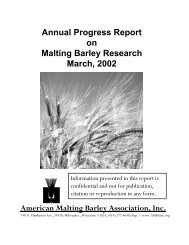Annual Progress Report on Malting Barley Research March, 2007
Annual Progress Report on Malting Barley Research March, 2007
Annual Progress Report on Malting Barley Research March, 2007
Create successful ePaper yourself
Turn your PDF publications into a flip-book with our unique Google optimized e-Paper software.
EARLY GENERATION LINES<br />
Forty F5 populati<strong>on</strong>s were grown at Crookst<strong>on</strong> and St. Paul. The populati<strong>on</strong>s were largely<br />
of two types, i.e., traditi<strong>on</strong>al elite by elite and elite by FHB resistant. Nine of the F5<br />
populati<strong>on</strong>s (elite by elite) al<strong>on</strong>g with eight populati<strong>on</strong>s segregating for resistance to net<br />
blotch or septoria were advanced through the F3 and F4 generati<strong>on</strong>s via single seed<br />
descent (SSD) in greenhouses in fall and winter 2005-2006. These populati<strong>on</strong>s were<br />
planted as F5 head rows in Crookst<strong>on</strong> or Stephen (net blotch) in the summer of 2006.<br />
Selecti<strong>on</strong> in these crosses was based <strong>on</strong> heading date, height, lodging, kernel plumpness,<br />
and spike characteristics. The Septoria and net blotch populati<strong>on</strong>s were planted in<br />
inoculated nurseries. We were unable to get good Septoria disease expressi<strong>on</strong> and<br />
therefore unable to select for resistance. These lines were screened for resistance to<br />
Septoria in the Fall greenhouse and resistant lines will be advanced to <strong>2007</strong> trials. Disease<br />
pressure at our net blotch nursery was light, so we also c<strong>on</strong>ducted greenhouse disease<br />
screening in the Fall. Twenty-four of the F5 populati<strong>on</strong>s (elite by FHB) were advanced to<br />
F3 in a fall 2005 greenhouse in Minnesota and then to the F4 as single plants in<br />
Christchurch, New Zealand. The New Zealand nursery allowed us to harvest enough seed<br />
from individual plants for replicated FHB nurseries in a timely manner for planting.<br />
Selecti<strong>on</strong> <strong>on</strong> FHB populati<strong>on</strong>s in the 2006 field seas<strong>on</strong> was based <strong>on</strong> FHB resistance,<br />
heading date, height, and lodging. Grain harvested from selected rows was analyzed for<br />
DON. In additi<strong>on</strong>, we plant a single row outside of the disease nursery for malting quality<br />
analysis in Madis<strong>on</strong>, WI. Heads from selected F5’s in 2006 were planted in single rows in<br />
a winter nursery (2006/<strong>2007</strong>) in Yuma, AZ to produce seed for 2006 PYTs. Based <strong>on</strong> 2006<br />
FHB, DON, and malting quality data and also phenotype in the Yuma nursery, about 200<br />
lines will be selected for entry to preliminary yield trials in <strong>2007</strong>.<br />
A total of 51 F2 populati<strong>on</strong>s were grown in the field at St. Paul and Crookst<strong>on</strong> in 2005. In<br />
additi<strong>on</strong>, we grew eight F2 populati<strong>on</strong>s in the summer greenhouse in c<strong>on</strong>es arranged in a<br />
96-well format to facilitate marker assisted selecti<strong>on</strong> (MAS). In these populati<strong>on</strong>s, we<br />
selected for markers linked to a QTL identified <strong>on</strong> chromosome 6(6) (Wingbermuehle et al.,<br />
2004) and markers linked to a QTL for resistance to Septoria speckled leaf blotch. Marker<br />
genotyping was d<strong>on</strong>e in collaborati<strong>on</strong> with Dr. Shiaoman Chao at the USDA Genotyping<br />
Lab in Fargo, ND.<br />
SCREENING FOR DISEASE RESISTANCE<br />
FHB<br />
Steady progress has been made in breeding for resistance to FHB. Funding through the<br />
US Wheat and <strong>Barley</strong> Scab Initiative and the Minnesota Small Grains Initiative have<br />
allowed us to sustain a major effort in disease resistance breeding and studies aimed to<br />
understand and exploit the genetics of disease resistance. Our FHB screening effort is<br />
c<strong>on</strong>ducted in collaborati<strong>on</strong> with Dr. Ruth Dill-Macky and Dr. Charla Hollingsworth. We are<br />
advancing resistant lines in our program tracing to different sources of resistance and<br />
c<strong>on</strong>tinue to make crosses with new sources of resistance as they are identified. We have<br />
been working with Dr. Brian Steffens<strong>on</strong> in selecting new sources of FHB resistance to<br />
introduce into the breeding program. Each year we have increased the number of entries<br />
23
















